Sharding: Resharding
- Resharding is the relocation of data stored on one shard to another shard, to maintain an overall balanced database in which all shards handle about the same volume of data.
- The resharding process moves all the data related to a certain bucket (including documents, document extensions, tombstones, etc.), to a different shard, and then associates the bucket with the new shard.
- An even distribution of data and workload between all shards maintains a steadier overall usage of resources like disk space, memory, and bandwidth, improves availability, and eases database management.
- Resharding can currently be initiated only manually, via Studio.
A user can reshard a range of buckets as well as a single bucket. -
When resharding is initiated, RavenDB implements it gradually, one bucket at a time, to avoid resource overuse.
-
In this page:
Resharding
Over time, data may be distributed unevenly between the database's shards, until some shards may host and handle a much bigger portion of the overall load than others.
Resharding is the process of re-distributing stored data between the shards.
Keeping about the same amount of data on all shards helps maintain an equal level of resource usage and improves the database's overall availability and querying speed.
Resharding is currently manual.
Resharding can currently be initiated manually, via Studio.
RavenDB provides a comfortable resharding interface and does alert
its users when disk space and other resources are exhausted, but it
is up to you to commence the resharding process when it is needed.
Resharding is carried out one bucket at a time.
The smallest unit that can be resharded is a single bucket with all its contents.
It is also possible to reshard ranges of buckets, but resharding is always done
one bucket at a time to keep the process light, avoiding any additional burden to
shards that may already be preoccupied.
The Resharding Process
Let's follow the resharding of a range of buckets from shard #0 to shard #2, using a database like the one shown below:
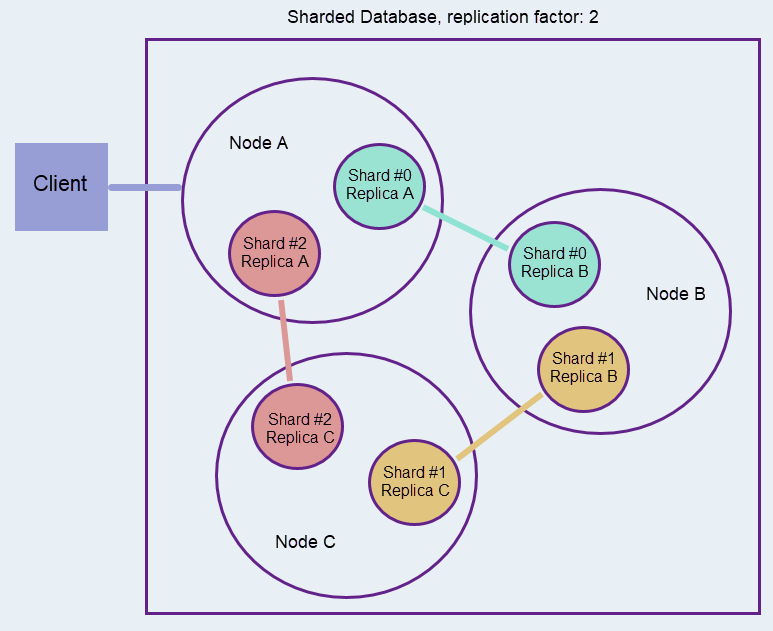
Sharded Database
- The client requests to reshard buckets from shard
#0to shard#2. - Shard
#0connects shard#2and transfers to it all the content of the first bucket. - Shard
#0remains the owner of the bucket until all data has been propagated to all shard#2replicas. - The ownership is transferred, the bucket is remapped to shard
#2. - Shard
#0starts purging all the entities whose ownership is now held by shard#2.
If there are still buckets to shift, shard#0can start transferring content from the next bucket.
Following Resharding Progress
You can follow the progress of the resharding progress using -
-
Studio Popup Messages
When Studio is used for resharding the user interface produces popup messages to keep users informed of its progress. -
The Database Record
All sharding-related info is stored in the database recordShardingproperty, where this info can be accessed by all shards.
During resharding, migrating buckets details like status, source shard, and destination shard, are updated in relatedShardingsub-properties.-
Via Studio
Open Studio's Database Record view and the Sharding property.
The details of currently-migrating buckets are recorded in theBucketMigrationproperty.
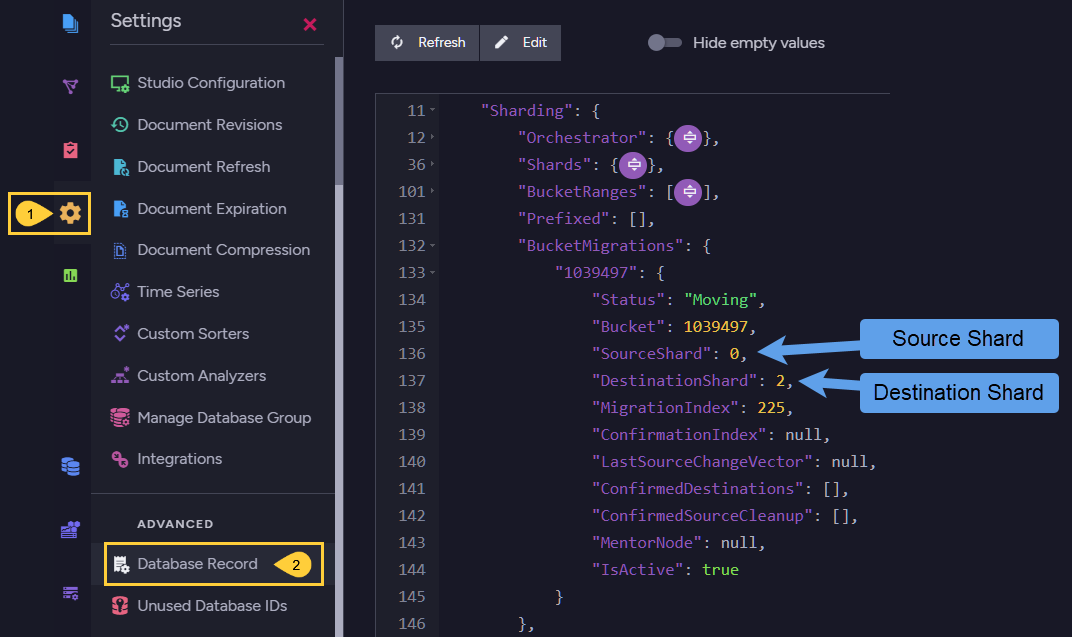 1. Click to open the Settings
1. Click to open the Settings
2. Click to view or edit the database record -
Via API
To get the database record via API, passGetDatabaseRecordOperationthe database name.
Open the database recordBucketMigrationproperty to check migrating buckets status, source and destination shards.
-
Racing
It may happen that a file (like a time series, due to the addition
of a time series entry) would find its way into a bucket after the
ownership of this bucket has already been shifted to another shard
and before RavenDB managed to delete it.
To handle such occurences, a periodic documents migrator task
routinely checks the system.
Upon locating a file in a bucket that is already owned by another shard,
the documents migrator task immediately initiates a new resharding process
for the related bucket.
Change Vector on a Sharded Database
On a non-sharded database, a document's change vector indicates both the document's version (so we can tell which version of it to replicate, for example) and its order on the database (so we can tell, for example, whether to replicate or skip it).
On a sharded database, the latter (order) property may turn meaningless, because resharding may change the order of documents: an old document may be moved to a shard that contains newer documents, and get a change vector newer than theirs.
To resolve this issue, resharded documents are given an altered change vector
that explicitly defines both their version and their order, using this format:
<order>|<version>
-
E.g.
Users/1 A:3|B:7
In the example aboveA:3|B:7isUsers/1's change vector.A:3indicates the document's order.- The
|symbol separates the two parts. B:7inidcates the document's version.
The change vector is altered this way only for documents that have been resharded.
Resharding and Other Features
Resharding and External Replication
During external replication:
- The order (left-hand) part of the document's change vector is checked on the source side, to determine whether the document should be replicated.
- The version (right-hand) part of the document's change vector is checked on the destination side, to determine whether this version of the document already resides on it.
Resharding and ETL
ETL tasks cannot determine whether a document that
was resharded does or doesn't exist on their target.
Therefore ETL tasks consider all resharded documents (that match the
transform script) new/modified and transfer them all to the destination.
Resharding and Data Subscriptions
Our promise to data subscription workers is that we
send all data at least once.
As in a non-sharded database, we do our best not to send documents twice, but it
is the responsibility of the worker to check whether a document is duplicated or not.
Resharding and Querying
Since documents are stored in their buckets along with all the data
related to them, including revisions, time series, attachments, and
so on, resharding a large document's bucket may take a considerable
amount of time.
During this time, checking which shard the bucket belongs to
may show
both the bucket's source and destination shards.
However, if documents stored in this bucket are queried
during this time, RavenDB will add them to the retrieved dataset
only once and prevent results duplication due to resharding.
Executing Resharding
Resharding can currently be initiated only via Studio.
To reshard selected buckets, open the Stats view.
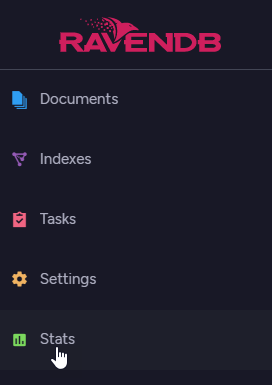
Stats View
Open the Buckets Report view.
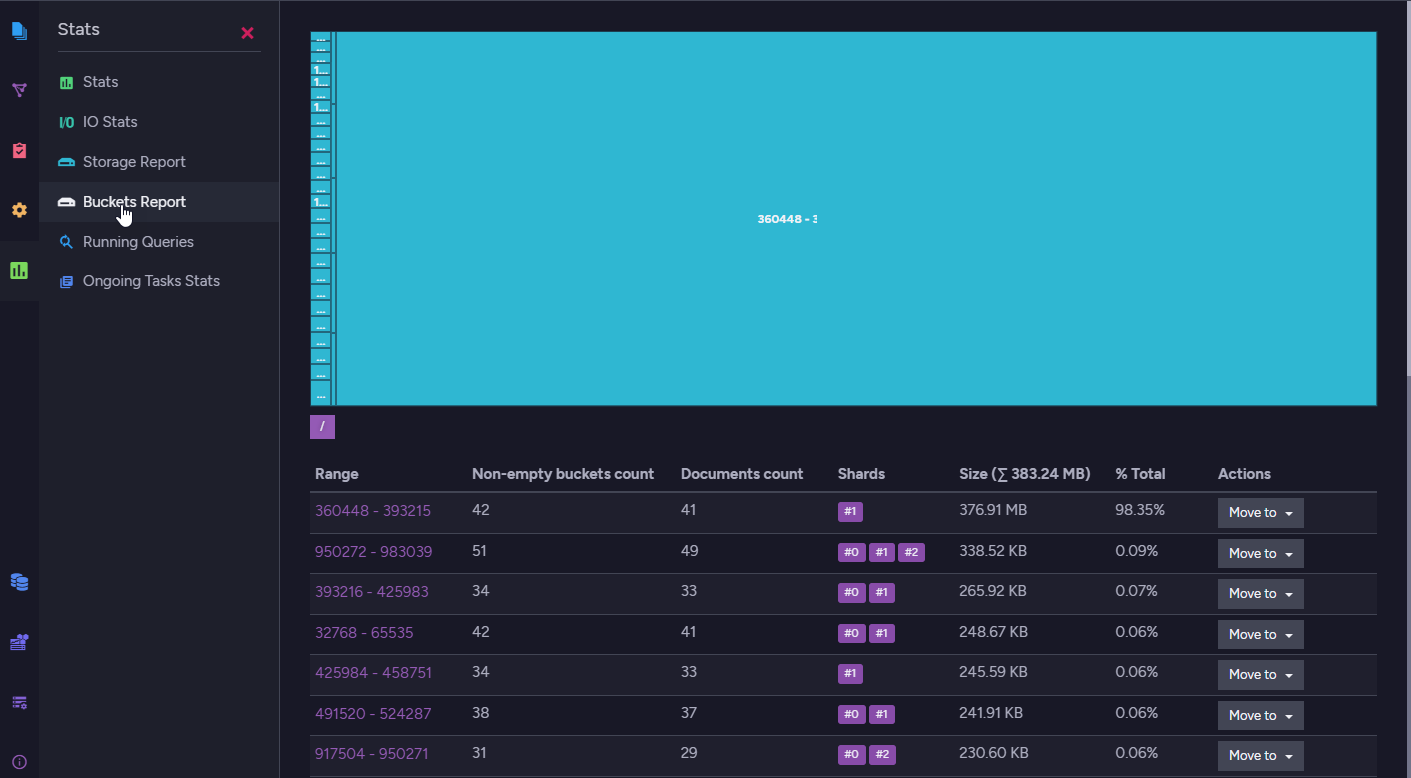
Buckets Report
Selecting a range of buckets will present the selected range.
You can reshard a whole range of buckets, or continue increasing the
resolution until you present a single bucket and the files it contains.
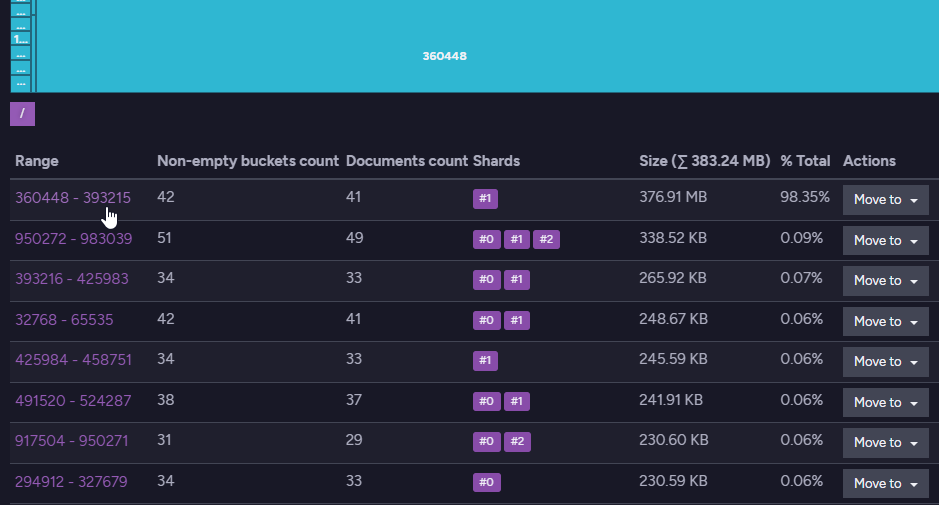
Range of Buckets
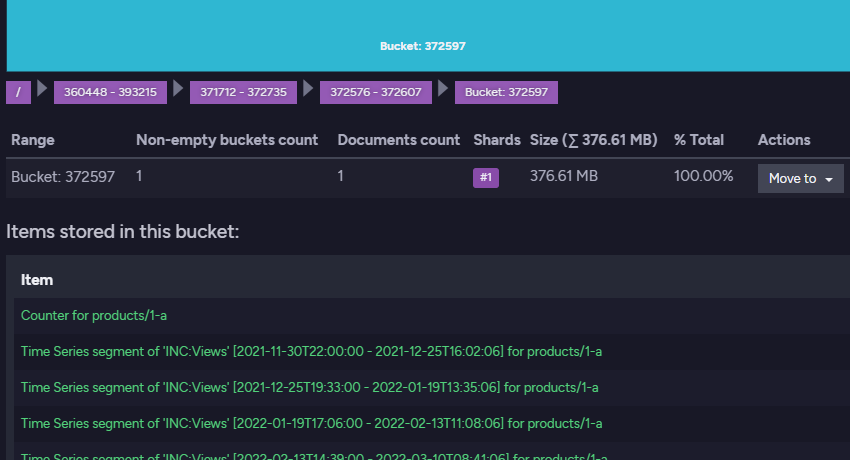
Single Bucket
Select the shard you want to transfer the bucket/s to and confirm the transfer
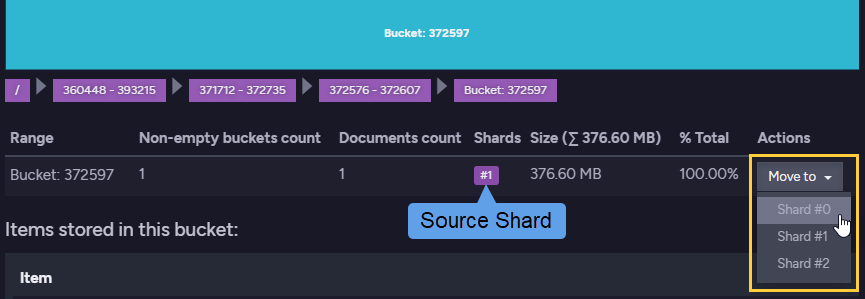
Reshard
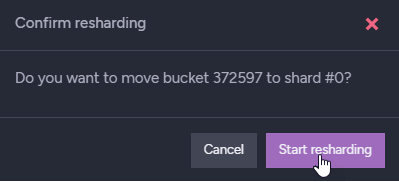
Confirm Resharding
Studio will indicate its progress in resharding the requested buckets range using popup messages until the process ends.
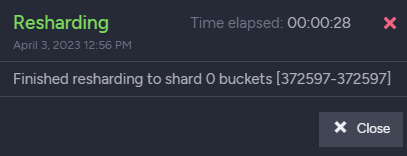
Finished Resharding
Bucket Ownership
For a while, as long as there are still entities to transfer to the new shard's replicas or delete from the old shard, transferred buckets are presented as if they reside on both their old and new shards.

Document On Two Shards
Eventually, the bucket/s reside on their new shard.
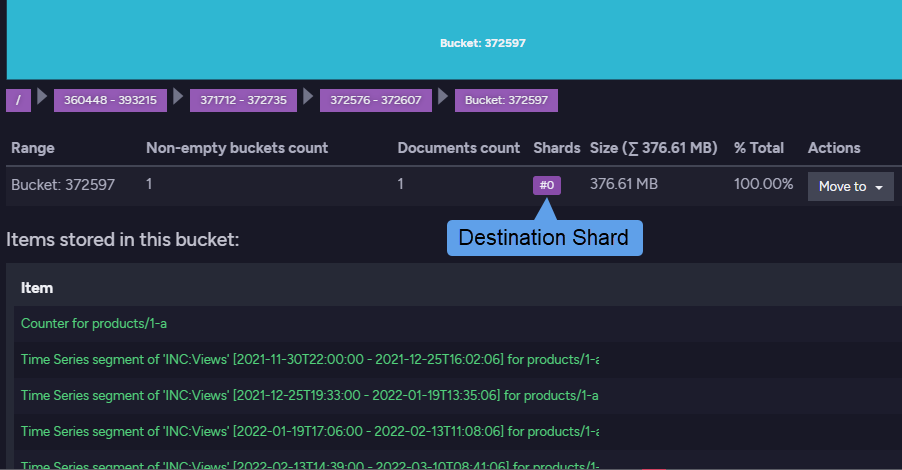
Post Resharding